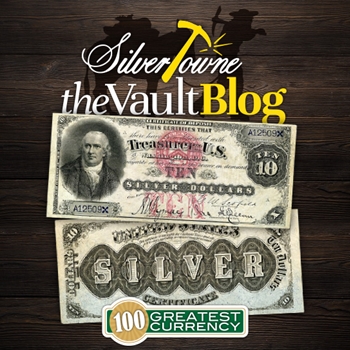
It is not uncommon anymore, especially as currency collectors, to hear about or see a silver certificate. Silver certificates are vast in availability now, but like numerous currency notes, were created for a sole purpose and were not always so available. The beginning of the silver certificates takes us back to the late 1870s and into the 1880s, which we will discover because of a specific series that has landed on Whitman Publishing’s 100 Greatest American Currency Notes. Authors Q. David Bowers and David M. Sundman will guide us through the entry focused on one denomination.
#63 – The First Silver Certificates $10 Silver Certificate, Series of 1878 and 1880
The $10 Silver Certificates began in 1878 and were closely followed up by the Series 1880. The notes feature Robert Morris, an early financier, on the face to the left of the center. SILVER is depicted on the back on the notes in large letters, which is said to have quite pleased Silverites, or members of a political movement in the United States in the late 19th century that believed silver should be a monetary standard along with gold.
The series was created to issue bills that were specifically payable in silver dollars, which were backed by Morgan dollars in storage. Unlike most but not all later issued silver certificates, the Series 1878 notes were payable at specific Sub-Treasury facilities in New York and San Francisco. The Treasury in Washington, D.C. was also on the list of facilities they were payable. Each note featured the printed signatures of Scofield and Gilfillan in addition to a countersignature. A small number of those were also autographed, making them more desirable in the series. Over 225,000 of the Series 1878 $10 Silver Certificates were printed, but less than 20 have been found. Most of the notes surviving is from the Series 1880.
Morris, who was featured on the notes, was born in England in 1733 and came to America when he was just 13 years old. He apprenticed at the counting-house of Charles Willing where he would later become partner. That partnership would last from 1754-1793. Willing, along with Morris, were the most prominent private financiers in Philadelphia prior to the American Revolution.
After the massacre of colonial troops by the British army in Lexington, Massachusetts, in April 1775, Robert Morris would align himself with his fellow Americans. He would become a member of the Continental Congress assisting in financial matters to which he would gain tremendous commanding importance during the war. In 1780 he was the proposer of the Bank of North America. When the financial institution was established in 1782, it became the first important financial institution in the nation. He was also the first to hold the federal office of superintendent of finance in 1781, which was the equivalent to the secretary to the Treasury in today’s language.
In 1960, the historic market value of the $10 Silver Certificate from the Series 1878 and 1880 was $650 for a Very Fine condition. By the publication of this edition (2006), the same note rose to $20,000. However, the triple signatures on the Series 1878 notes are much rarer and in greater demand.







